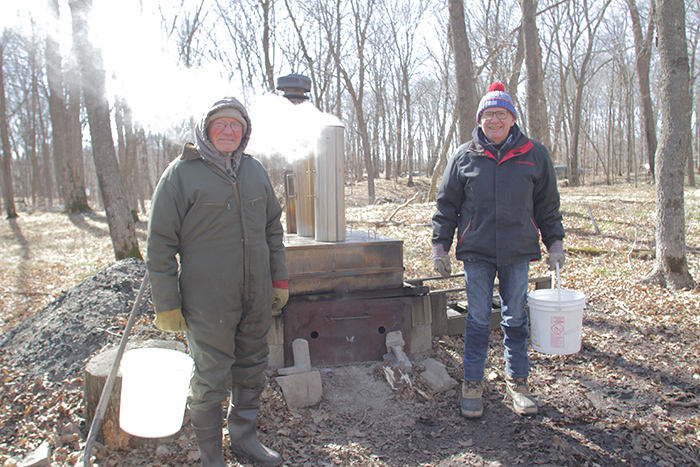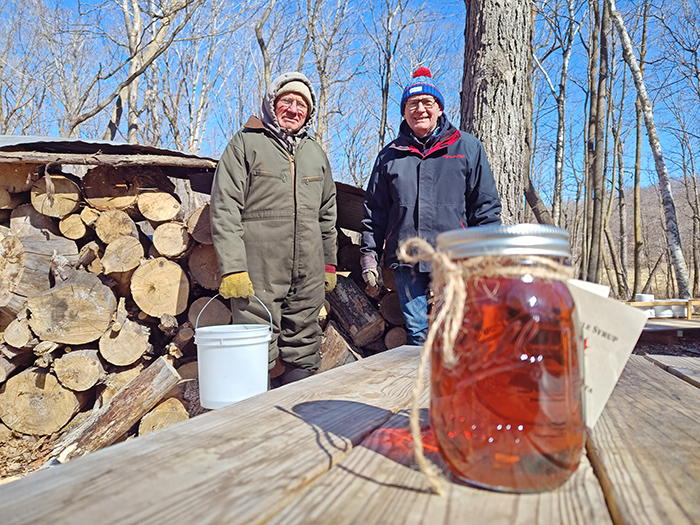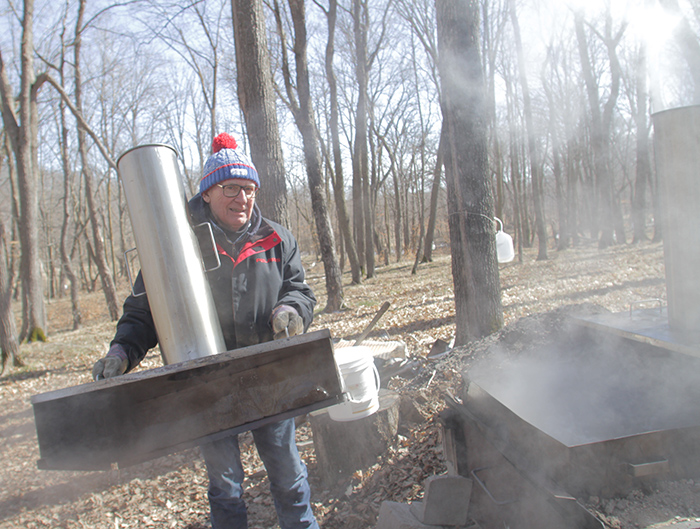Two old saps yuck it up while tapping sugar maples
News | Published on April 8, 2025 at 2:27pm EDT | Author: frazeevergas
0Syrup processing brings friends together each spring

Russell Sauer and George Frankberg prepare to load more sap into the evaporator atop the 25-year-old fire pit they use to process maple syrup.
By Robert Williams
Editor
Down a muddy four-wheel track off the beaten path hidden somewhere in the Vergas Trails sits a quarter-century old fire pit with a double-piped, stainless steel, evaporator closely guarded by two old saps, George Frankberg and Russell Sauer.

The sugary spot in the woods was tapped a quarter of a century ago by Tom Franklin and his father George. It’s a multi-family operation: Frankberg is Tom’s uncle and Russell is Tom’s cousin, yet the duo are not related. After 80 years of friendship, they might as well be.
Frankberg started collecting sap with his family 72 years ago near Dead Lake when he was eight-years-old.
“That’s how I first got associated with maple syrup and the process and then with Tommy getting involved, it was just natural and fun stuff. Tommy is an enthusiastic guy, fun guy and we just have a good time.”
Sauer began working the sugar maples with Charles Franklin 25 years ago.

“Oh Gosh, he did it every year for about 20 years and then Tommy took it over,” Sauer said. “Charles passed on and now Tommy’s in charge.”
There seems to be countless ways to process the sap into syrup. Last year, the Forum featured Stu Peterson, the 2024 inductee to the International Maple Museum Hall of Fame. Peterson taps around 1,000 trees each year utilizing reverse osmosis in a state-of-the-art sugar shack creating Camp Aquila Pure Maple Syrup near Star Lake in Dent.
Peterson returns to host his presentation on the process during Maple Syrup Festival in Vergas Saturday, April 12, at Billy’s Corner Bar and Grill at 10 a.m.
Be that as it may, George and Russell have their own opinion on how to properly turn sap to syrup.

“Ours is the best way,” Frankberg laughed.
“It’s laborious,” said Sauer. “But it’s a lot of fun.”
Franklin and Frankberg are in charge of tapping the trees.
“It’s gotta be just right and you have to get that hose in there real tight,” Frankberg said.
Franklin shows up each morning around 10 a.m., to collect the sap from the one-gallon distilled water containers on each tree, filter it and then fill the cooker with sap and fire it up.
“It’s about a four-hour process,” he said.
Sauer joins around 2 p.m., for the next collection and Franklin takes over the night shift around 5 p.m.
Collection is not an easy job. The terrain around the base camp is hilly, littered with downed branches and plenty of mud. The duo use four and five-gallon buckets to retrieve the sap.
“We’re carrying those puppies in from as far away as 300-feet or so,” Frankberg said. “After two hours of that, I’ve about had enough. It’s fun, but I don’t go to the health club while we’re doing this.”
The duo have been meeting daily during the season in their syrup spot for the past seven years collecting sap from approximately 160 trees.
“The boiling is kind of a critical operation and the sap boils down to get that 40:1 ratio and you’ve really got to watch it to evaluate your density,” said Sauer. “If it overheats it’s sugar locked. It’s like asphalt on a parking lot. It’s a real pain.”
On average, 40 gallons of sap are boiled down to produce one gallon of maple syrup. This 40:1 ratio is a benchmark, but it can fluctuate. The actual ratio can range from 20:1 to 60:1, depending on the sap’s sugar content. The higher the sugar content, the less sap is needed.
“You eyeball it and the closer you get you use your hydrometer,” said Sauer.
Part of the draw of doing the job is more than making syrup. It’s the laughs the two share together and the ambience of being out in the sugar maple forest.
“We think we’re cool as can be,” Frankberg said. “We’re out here in the woods and the same two trumpeter swans come over, the same two swans that have been here for several years. Call me stupid, but that’s the kind of stuff I like.”
Both men own property about halfway between Vergas and Detroit Lakes. Sauer has a farm about a half-mile from Frankberg’s home near Lake Melissa.
The two went to high school together in Detroit Lakes. Frankberg is a Class of ‘62’ and Sauer a graduate of 1963.
Russ and his wife Sharon had three children, two boys and a girl, and eight grandchildren. George and his wife Margie had three kids, two boys and a girl, and seven grandchildren.
“We’ve been very fortunate with some of the mistakes we’ve made with fatherhood and parenthood and all that,” Russ said.
Both men have plenty of acreage at their homes, George owns 80 acres and Russ lives on hundreds of acres of pristine farmland.
“I feel so blessed,” George said. “I live in a swamp but it’s the most beautiful swamp you’ve ever seen.”
Part of working the sap is telling old tales of the two saps, or as George puts it, another story about how stupid we are.
In 1961, when the two were about 14 and 15-years-old, Russ had a friend over at Sauer Lake and George stopped over.
“We were swimming and putzing around,” Russ said. “George had to go to work at the golf course in Detroit Lakes and we said, you know, I wonder how far it is across the lake? The friend had polio so he wasn’t the best swimmer. We also had a dog and an inner tube and as we were leaving the friend said, ‘leave it here.’ I insisted we took it. If it hadn’t been for that inner tube, when we think of it at this age, it’s proof that we are stupid. It was about a half-mile swim.”
“We went all the way across the stupid lake and that was the dumbest thing and then I had to run back. I was really in a hurry running through the stubble field there in our bare feet,” said George.
“He was already about a half hour late for work and he didn’t want to get under the gun again. Honorable mention, he didn’t get fired,” said Russ.
Regular visitors come to hear the zany tales of Russ and George and to help out with the processing.
“The jugs get heavier later in the day when it’s this cold,” George said. “We have people coming out here regularly,” George said.
During this interview, a fellow maple tapper was just lingering around the boil site listening in and a day before this interview, a group of four kids and their mother stopped out.
“These kids stayed with it right to the bitter end and we got 120 gallons and they carried a lot of it,” said George.
“They were good kids,” said Russ.
While George and Russ have been lifelong friends, they separated after high school on their own paths and got together occasionally with their families over the years.
After high school, Sauer was drafted into the service and worked in the hospital.
He served in Korea and following the U.S. Army tour he received the G.I. Bill and went to school to pursue a medical degree at the University of Minnesota.
“It was wonderful,” said Sauer.
He stayed in the Twin Cities metro for a decade before relocating back to the Vergas area.
“I’ve been working in the hospital ever since,” Sauer said.
Russ is still a working anesthetist to this day, currently at Essentia Health, a career that began as an operating room technician in the military.
“I continue to work at it diligently,” said Sauer.
Russ is very understated about his profession, as he is about his military career. Being a good anaesthetist, according to him, is a simple process.
“You want to pay attention,” he grinned. “It does test you at times when something goes wrong. It does not happen often, just to be alert and prevent it and hopefully foresee it coming and not to have an accident. That’s truly the biggest fear.”
One need not fear around George, for another tale that appears to be rather tall is completely true and coming right at you.
“This is the highlight of my life,” he said.
Take a moment to soak that statement in.

George Frankberg’s annual count of revenge skunk killings has reached 100 skunks trapped and dispatched. “This is the highlight of my life,” he said.
“I have taken out 100 skunks, as of two weeks ago,” George said in all seriousness. “This is my 11th year of trapping skunks and I’ve reached the milestone of 100 skunks!”
George’s beef with skunks is a story of revenge against a skunk that caused the death of two of George’s ducks 11 years ago.
“The skunk murdered my two ducks; that’s how I got in the business,” he said.
One of George’s sons is the “official skunk accountant,” and produces an annual report.
“The two record years were 20 skunks; the second year I trapped it was 20 and then again in 2003; so far, this year I only have two, but it got me to the 100.”
George’s tale, much like his personality, is a boisterous romp with a good fortune involved.
After graduation, Frankberg climbed into his 1948 Chevy in the fall and went to Moorhead State University and four years later he was pumping gas at M&H before he got his first career job opportunity at First National Bank in Fargo as a computer operator.
A friend had encouraged George to apply and he was too scared not to.
“They checked me out like crazy and offered me the job,” he said. “I’m so stupid; I went back to M&H and I said, ‘They’ve offered me a dollar-and-a-half an hour.’ I was getting $1.35 at M&H and I said, ‘If you’ll match that I’ll stay.’”
The buck-fifty was management-level pay at M&H, so a raise was out of the question.
George took the job at the bank.
“I worked real hard and I had some luck,” Frankberg said.
He began as a nighttime computer operator in the days of room-sized computers, punch cards and all that. A spot opened up when a day shift worker was fired and George was put in charge of the night operators. A year later, an opening appeared when a computer programmer quit.
“They asked me if I was interested and sent me to school; I learned how to program computers,” Frankberg said.
He continued managing the night operators, while programming and moved to a higher management position when the man he replaced was transferred to Minneapolis.
“This is in the right place and right time, luck and timing, I lived that because I wanted to keep pumping gas,” Frankberg exclaimed.
Instead, he was the manager of the largest department in the largest bank in North Dakota at 23-years-old.
“You know how smart I was at 23?” he said.
“George and Einstein are first cousins,” Sauer laughed.
Five years later, Frankberg found himself in what he calls the wrong place at the right time earning his own transfer to Minneapolis.
“The reality of a big corporation set in and I was too stupid to leave there,” he said.
A company out of Cleveland saved him by hiring him to sell and install computer accounting systems in the Twin Cities and Chicago. He opened an office in Chicago and worked there for 10 years.
While still in Chicago, George opened the Stone Heart (formerly the Hilltop Club) on Rose Lake with his wife Margie and his sister Mary Ann Franklin. They operated the restaurant for a dozen years.
George took another high-travel position with Human Resources Outsourcing, hiring truck drivers, leasing the drivers to truck owners.
The company was an early form of headhunter and contractor-based business.
Frankberg sold his Chicago business in 2000.
“The best part of Chicago was seeing it in my rearview mirror for the very last time,” he said.
George moved back to this area full-time where he worked at another burgeoning business model, this time online at KeepItLocal.com.
“That was my first retirement job for 13 years,” he said.
After 13 years, the competition online had erupted. Frankberg brokered a sale of the site to a man in Sioux Falls, who he worked for a couple of years. He then moved to AM 1100 The Flag in Fargo selling advertising on the Rush Limbaugh show.
“And now, I do sap with my buddy Russ,” Frankberg said. “We think it’s really cool and it’s really healthy,”
Vergas will be full of syrup Saturday, April 12, during the village’s annual Maple Syrup Festival. Check out the Vergas Community Club page and the Maple Syrup Festival page on Facebook for the full itinerary.

